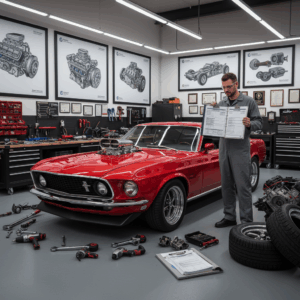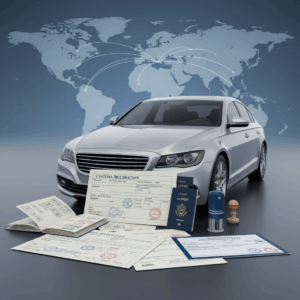Overview of Car Import Regulations
Car import regulations define the legal requirements and standards for vehicles entering a country, impacting market competition, safety, and tax collection. These rules are essential for governments and industries alike.
Understanding import regulations helps businesses and consumers navigate complex procedures, ensuring vehicles comply with local laws and meet safety and environmental standards. This knowledge supports smoother transactions and market stability.
Legal Framework and Documentation
The legal framework for car imports includes laws, decrees, and official documentation required to authorize vehicle entry. These regulations differ significantly by country to align with local policies and priorities.
Documentation typically involves import permits, proof of ownership, compliance with safety and environmental certifications, and payment of duties and taxes. Accurate paperwork is critical to avoid legal penalties and delays.
For example, Mexico recently extended the validity period for legal import of used cars but struggles with controlling undocumented vehicles, which affects vehicle quality and fiscal revenues.
Common Regulatory Goals
Regulations commonly aim to protect local industries, enhance road safety, control environmental impact, and generate public revenue. These goals balance market openness with national interests.
Policies may restrict imports to new vehicles or collectible models, as seen in Brazil, to protect local manufacturers and maintain vehicle standards. Such rules also influence vehicle availability and pricing.
In the U.S., tariffs on imported cars seek to support domestic producers but can raise prices and limit consumer choice. Overall, these goals seek to create a regulated and fair automotive market environment.
Country-Specific Import Rules
Mexico’s Import Decrees and Their Effects
Mexico has enacted a decree extending the legal import period for used cars, offering importers regulatory certainty when complying with documentation and fees. This helps streamline legal imports.
However, the presence of a concurrent decree facilitating the legalization of «autos chocolate,» or smuggled vehicles, raises concerns. Over 2.5 million such cars entered without proper controls, affecting safety and tax revenues.
This dual regulatory environment creates challenges for businesses and authorities alike, requiring vigilant monitoring of potential policy shifts and addressing risks linked to unregulated vehicles on the roads.
Brazil’s Restrictive Policies on Vehicle Imports
Brazil restricts vehicle imports primarily to brand-new cars, except for vintage automobiles older than 30 years registered with collector clubs. This policy aims at protecting domestic industry and vehicle standards.
The import process is complex, demanding rigorous environmental and safety certifications that lengthen clearance times. These barriers limit foreign models, making imports exclusive and often pricier for consumers.
By enforcing strict rules, Brazil seeks to sustain its local automotive sector, but this also narrows consumer options, raising questions about market competitiveness and availability of diverse vehicles.
United States Tariffs and Market Impact
The U.S. applies tariffs of up to 25% on imported vehicles to protect domestic manufacturers. This trade policy affects global exporters like Japan, South Korea, and Germany by reducing their sales in the large U.S. market.
While tariffs may temporarily benefit American automakers, they increase costs for manufacturers who rely on imported parts, pushing up prices and affecting the supply chain for vehicles and components.
Some European exporters, such as Spain, experience minimal impact due to limited car exports to the U.S., though their component suppliers can feel pressure. Tariffs consequently reshape competition and pricing.
Industry Implications of Import Regulations
Import regulations profoundly influence the automotive industry by shaping competition, pricing, and market dynamics. These rules affect manufacturers, importers, and consumers alike.
The economic landscape changes as regulations impose tariffs, restrict imports, or encourage certain sectors, directly impacting business strategies and industry growth potential.
Competitive and Economic Effects
Import restrictions can protect local manufacturers by limiting foreign competition, often leading to higher vehicle prices and reduced consumer choice. This protection can foster domestic industry growth.
Conversely, tariffs and bans may increase production costs for companies relying on global supply chains, potentially reducing efficiency and competitiveness in the international market.
For example, U.S. tariffs have benefited some domestic producers while raising prices, impacting global exporters and reshaping trade flows and investment decisions in the automotive sector.
Regulations also create niche opportunities for specialized imports, such as classic or luxury vehicles, enabling importers to target specific market segments despite broader restrictions.
Safety and Environmental Considerations
Car import rules often include safety and environmental standards to ensure vehicles meet local regulations, protecting consumers and promoting sustainable transportation.
Strict certification requirements, like those in Brazil, help maintain high safety levels and reduce environmental impacts, but can complicate import procedures and raise costs.
The influx of non-compliant or smuggled vehicles, as seen with Mexico’s “autos chocolate,” undermines safety standards and can increase pollution, posing risks to public welfare.
Balancing Industry and Public Interests
Effective import regulations balance economic growth with safety and environmental concerns, encouraging innovation while safeguarding road users and ecosystems.
Continuous monitoring and adaptation of these rules are essential to address evolving challenges, such as new vehicle technologies and global trade changes, ensuring a responsible automotive market.
Strategies for Navigating Import Regulations
Successfully navigating car import regulations requires businesses to prioritize compliance and proactive risk management. Understanding evolving rules minimizes legal issues and operational disruptions.
Adapting to market conditions and leveraging regulatory knowledge creates opportunities for importers and manufacturers to access niche segments and optimize product offerings across borders.
Compliance and Risk Management
Compliance with import regulations demands thorough documentation, adherence to customs procedures, and timely payment of duties. Companies must constantly monitor changes to avoid penalties or shipment delays.
Risk management involves assessing potential regulatory shifts and their impact on supply chains. Proactively adjusting strategies can mitigate legal exposure and financial losses while maintaining market stability.
For example, close observation of Mexico’s dual regulatory environment and Brazil’s strict import rules enables importers to plan accordingly and ensure legal vehicle entry amid complex frameworks.
Opportunities in Market Adaptation
Regulatory restrictions can also open doors for businesses capable of identifying niche markets, such as limited-edition models or classic vehicles allowed under specific import rules.
Companies that innovate by tailoring product lines to meet local safety and environmental standards may gain a competitive edge and build customer trust in regulated markets.
Leveraging Regulatory Knowledge for Growth
Staying informed about international and local regulations allows firms to anticipate policy changes, giving them time to adapt their import strategies effectively and capitalize on emerging opportunities.
This approach fosters resilience, enabling businesses to sustain operations despite fluctuating tariffs or restrictions, thus supporting long-term growth and market presence.







